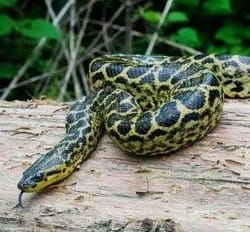Post by dinosauria101 on Apr 22, 2019 16:26:55 GMT 5
African Rock Python - Python sebae
Python sebae, commonly known as the African rock python, is a large, nonvenomous snake of Sub-Saharan Africa. The African rock python is one of seven species in the genus Python. It has two subspecies: one found in Central and Western Africa, the other in Southern Africa. Africa's largest snake species and one of the world's largest, the typical African rock python adult measures 3 to 3.53 m (9 ft 10 in to 11 ft 7 in) in total length (including tail), with only unusually large specimens likely to exceed 4.8 m (15 ft 9 in). Reports of specimens over 6 m (19 ft 8 in) are considered reliable, although larger specimens have never been confirmed. Weights are reportedly in the range of 44 to 55 kg (97 to 121 lb), per one study adults are expected to weigh only up to 32.2 kg (71 lb). The southern subspecies is generally smaller than its northern relative. The animal has a pattern of colored blotches on its body. It has dual lungs and vestigial hind limbs, which show it is less advanced in evolution than other snakes. The snake is found in a variety of habitats, from forests to near deserts, although usually near sources of water. The African rock python kills its prey by constriction and often eats animals up to the size of antelope, occasionally even crocodiles. The snake reproduces by egg-laying. Unlike most snakes, the female will protect her nest and sometimes even her hatchlings. The snake is widely feared even though it only very rarely kills humans. Although the snake is not endangered, it does face threats from habitat reduction and hunting.

Yellow Anaconda - Eunectes notaeus
Eunectes notaeus (common names: yellow anaconda, Paraguayan anaconda) is a nonvenomous boa species found in South America. No subspecies are currently recognized. The generic name Eunectes derives from Greek and means “good swimmer”; the Neo-Latin specific name notaeus derives from Greek νωταίος/nōtaios (poetic form of Greek νωτιαίος/nōtiaios), here meaning “dorsal.” In distinguishing his new species Eunectes notaeus from Eunectes murinus, Edward Drinker Cope stated: “Dorsal scales are larger and in fewer rows." Adults are not as large as the green anaconda, E. murinus, but nevertheless grow to an average of 3.3 to 4.4 m (11 to 14 ft) in length. They commonly weigh 25 to 35 kg (55 to 77 lb), though large specimens can weigh 40 to 55 kg (88 to 120 lb) or even more. The maximum size can certainly be larger, although confusion with its larger cousin may complicate matters. Female yellow anacondas have reportedly been measured up to 4.6 m (15 ft). Females are larger than males. The color pattern consists of a yellow, golden-tan or greenish-yellow ground color overlaid with a series of black or dark brown saddles, blotches, spots and streaks. This species prefers mostly aquatic habitats, including swamps, marshes, and brush-covered banks of slow-moving rivers and streams.

Credit to Wikipedia
Python sebae, commonly known as the African rock python, is a large, nonvenomous snake of Sub-Saharan Africa. The African rock python is one of seven species in the genus Python. It has two subspecies: one found in Central and Western Africa, the other in Southern Africa. Africa's largest snake species and one of the world's largest, the typical African rock python adult measures 3 to 3.53 m (9 ft 10 in to 11 ft 7 in) in total length (including tail), with only unusually large specimens likely to exceed 4.8 m (15 ft 9 in). Reports of specimens over 6 m (19 ft 8 in) are considered reliable, although larger specimens have never been confirmed. Weights are reportedly in the range of 44 to 55 kg (97 to 121 lb), per one study adults are expected to weigh only up to 32.2 kg (71 lb). The southern subspecies is generally smaller than its northern relative. The animal has a pattern of colored blotches on its body. It has dual lungs and vestigial hind limbs, which show it is less advanced in evolution than other snakes. The snake is found in a variety of habitats, from forests to near deserts, although usually near sources of water. The African rock python kills its prey by constriction and often eats animals up to the size of antelope, occasionally even crocodiles. The snake reproduces by egg-laying. Unlike most snakes, the female will protect her nest and sometimes even her hatchlings. The snake is widely feared even though it only very rarely kills humans. Although the snake is not endangered, it does face threats from habitat reduction and hunting.

Yellow Anaconda - Eunectes notaeus
Eunectes notaeus (common names: yellow anaconda, Paraguayan anaconda) is a nonvenomous boa species found in South America. No subspecies are currently recognized. The generic name Eunectes derives from Greek and means “good swimmer”; the Neo-Latin specific name notaeus derives from Greek νωταίος/nōtaios (poetic form of Greek νωτιαίος/nōtiaios), here meaning “dorsal.” In distinguishing his new species Eunectes notaeus from Eunectes murinus, Edward Drinker Cope stated: “Dorsal scales are larger and in fewer rows." Adults are not as large as the green anaconda, E. murinus, but nevertheless grow to an average of 3.3 to 4.4 m (11 to 14 ft) in length. They commonly weigh 25 to 35 kg (55 to 77 lb), though large specimens can weigh 40 to 55 kg (88 to 120 lb) or even more. The maximum size can certainly be larger, although confusion with its larger cousin may complicate matters. Female yellow anacondas have reportedly been measured up to 4.6 m (15 ft). Females are larger than males. The color pattern consists of a yellow, golden-tan or greenish-yellow ground color overlaid with a series of black or dark brown saddles, blotches, spots and streaks. This species prefers mostly aquatic habitats, including swamps, marshes, and brush-covered banks of slow-moving rivers and streams.

Credit to Wikipedia




